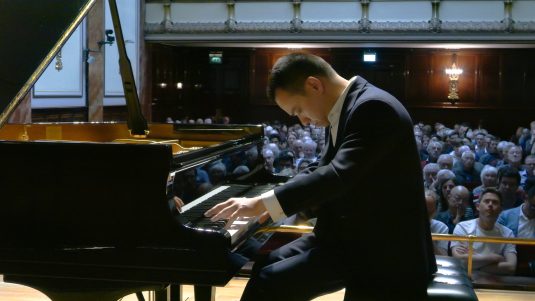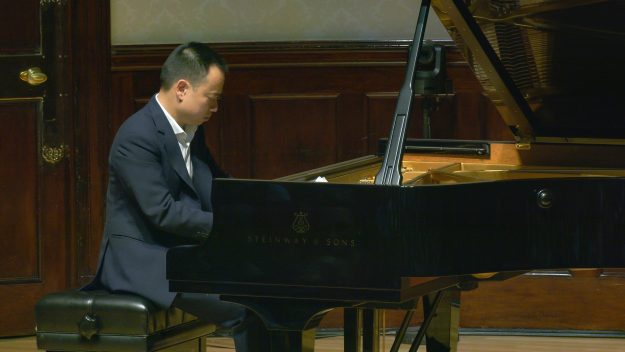 United Kingdom Alkan, Concerto for Solo Piano, Op.39 Nos. 8-10: Paul Wee (piano). Wigmore Hall, London, 15.6.2024. (CC)
United Kingdom Alkan, Concerto for Solo Piano, Op.39 Nos. 8-10: Paul Wee (piano). Wigmore Hall, London, 15.6.2024. (CC)

With his recordings for BIS, Paul Wee has gathered quite a following. He goes against current trends by manifesting as a real polymath: he is a fine concert pianist and also has attained high success within the legal profession.
But it is to the former that he inclined for this, a rare performance of Charles-Valentin Alkan’s Concerto for Solo Piano (the opus number, Op.39, Nos. 8-10, gives an idea of the scale the composer was aiming for; Op.39 is actually Twelve Etudes in all the Minor Keys). A whole concerto of some 50 minutes duration-plus, as part of a larger set is just remarkable.
Wigmore Hall was packed out, and the standing ovation at the end instantaneous and prolonged – and deserved. Performances of Alkan are rare indeed, despite the support of such giants as Raymond Lewenthal, Ronald Smith (readers of my generation will remember his HMV LPs), John Ogdon (who recorded the present work for RCA) and of course Marc-André Hamelin.
For all of the difficulties to come, it can be the smaller things which count. The way Wee’s opening chords were so preternaturally together set the stall for a performance of great integrity. In lesser hands, Alkan’s predilection for tremolos in a quasi-symphonic manner could become hackneyed; not with Wee, who saw it as very much part of Alkan’s expressive palette. It was interesting to see Wee use the third pedal to sustain a mid-range line while staccato chords surrounded it (and then to launch into cascades of arpeggios Liszt would have been proud of). The following section could potentially be labelled as ‘Chopinesque’, with its cantabile lines in a quasi-operatic manner, were it not for Alkan’s delicious melodic tweaks.
As a pianist, Wee is markedly undemonstrative. For all of the sparkling prestidigitation, massive chords, finely worked textures and awareness of Alkan’s use of gesture, Wee hardly moves at all. It all happens via the body and the fingers with a little help from those pedals. But most of all, he sustained the half-hour argument of the first movement to perfection.
The remaining two movements are briefer (about twelve and nine minutes respectively). A slow movement from Alkan is never going to be straightforward, and so it was. The Adagio begins with a melody that appears to be a blossoming of that Chopinesque trait. With Wee, inner voices were alive; a shadow of a waltz started to haunt the scene before the piano imitates the ‘drums’ of a funeral march. Alkan deliberately writes very low, so the pitches meld into a subterranean noise, like a muffled bass drum. Wee’s superb sense of rhythms ensured the ongoing tread was as relentless as it was oppressive.
Neither is the finale straightforward. This is marked Allegretto alla barbaresca, and barbarous it certainly was at times. But against that are sparkling runs and trills of positively diabolic intent. This, perhaps, in dance terms is Alkan’s equivale of Ravel’s La valse. Alkan sets up wave after wave of pianistic super-virtuosity; Wee rode every wave with aplomb while maintaining tension and a sense of drama (and storytelling) throughout. There is, surely, a nod to the Liszt B minor at one point (the two works are only a few years apart)
Unbelievably, Wee provided an encore, the slow movement of the Adolf von Henselt Piano Concerto, around eight minutes of bliss, a divine melody accorded the most delicious filigree. Remarkable.
Colin Clarke
Featured Image: Pianist Paul Wee makes his solo recital debut at the Wigmore Hall performing Alkan’s Concerto for Solo Piano © The Wigmore Hall Trust
